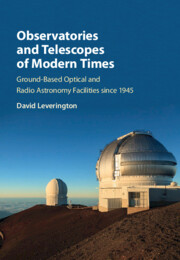 Observatories and Telescopes of Modern Times
Observatories and Telescopes of Modern Times from Part 1 - Optical Observatories
Published online by Cambridge University Press: 15 December 2016
European Northern Observatory, Canary Islands
Night-time Telescopes on Tenerife
The Astronomer Royal for Scotland, Charles Piazzi Smyth, set up two small astronomical stations at high altitude on Tenerife in the Spanish Canary Islands in 1856. Although they were not there for very long, these observatories were the first to show the great advantage of observing at high altitude.(1) No one took much notice, however, and it was not until over fifty years later that Jean Mascart of the Paris Observatory suggested that an international astronomical observatory should be established on Mount Guajara on Tenerife. Discussions then started between the Spanish, French and German governments, but they were abandoned at the start of the First World War.
There was no progress with the idea of setting up an observatory at high altitude in the Canaries for a number of years. But astronomers observed a total solar eclipse from the Canaries in 1959. In the same year Spain founded the Observatorio del Teide at Izana, on Tenerife, at an altitude of 2,380 m (7,250 ft). A 30 cm (12 inch) French photopolarimeter was installed there in 1964 to study the zodiacal light, followed by a Spanish 25 cm heliographic telescope in 1969. The largest telescope at El Teide (now part of the European Northern Observatory) is the UK's 1.5 m Infrared Flux Collector (IRFC) that was built in 1971 as the prototype for the 3.8 m United Kingdom Infrared Telescope that was completed on Mauna Kea eight years later.
Site surveys carried out by JOSO (Joint Organization for Solar Observations) in the 1970s indicated that although El Teide on Tenerife was the better Canary Islands site for solar observations (see Solar telescopes later), the Roque de los Muchachos on La Palma was better for night-time observations. So although night-time telescopes continued to be built at El Teide (see Table 6.1), the largest such telescopes were built on La Palma (see Table 6.2).
To save this book to your Kindle, first ensure [email protected] is added to your Approved Personal Document E-mail List under your Personal Document Settings on the Manage Your Content and Devices page of your Amazon account. Then enter the ‘name’ part of your Kindle email address below. Find out more about saving to your Kindle.
Note you can select to save to either the @free.kindle.com or @kindle.com variations. ‘@free.kindle.com’ emails are free but can only be saved to your device when it is connected to wi-fi. ‘@kindle.com’ emails can be delivered even when you are not connected to wi-fi, but note that service fees apply.
Find out more about the Kindle Personal Document Service.
To save content items to your account, please confirm that you agree to abide by our usage policies. If this is the first time you use this feature, you will be asked to authorise Cambridge Core to connect with your account. Find out more about saving content to Dropbox.
To save content items to your account, please confirm that you agree to abide by our usage policies. If this is the first time you use this feature, you will be asked to authorise Cambridge Core to connect with your account. Find out more about saving content to Google Drive.